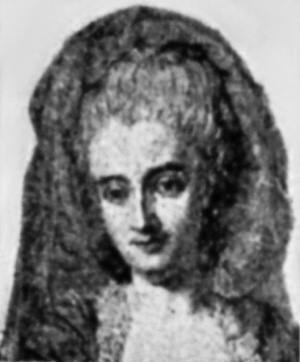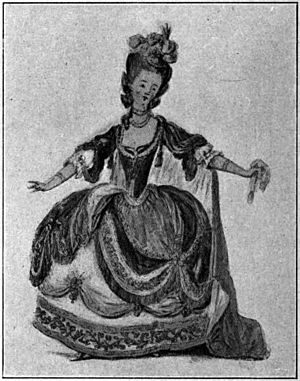Elisabeth Olin facts for kids
Elisabeth Olin (born Lillström, December 1740 – 26 March 1828) was a famous Swedish opera singer and a composer. She was a true pioneer! Elisabeth Olin sang the main female role when the Royal Swedish Opera first opened in 1773. Because of this, many people call her Sweden's first "prima donna" – which means a leading female singer.
She was also the first woman to be named Hovsångerska (Singer of the Royal Court) in 1773. Later, in 1782, she became the first woman to join the Royal Swedish Academy of Music.
Contents
Elisabeth Olin's Early Life and Talent
Elisabeth Olin was born into a family of artists. Her father, Petter Lillström, was a musician. Her mother, Elisabeth Lillström, was an actress and singer. Both her parents worked at the Bollhuset theater, which was Sweden's first professional stage. Her father played the organ in the theater orchestra. Her mother was a leading actress and singer there.
Starting Young: A Child Star
Elisabeth, known as Betty Lillström back then, started performing very young. At just seven years old, in 1747, she debuted at Bollhuset. She played the part of Alfhild in Syrinx, which was Sweden's first native Opera comique. She was a popular child actor and was seen as a valuable part of the theater.
After 1754, the Swedish-language theater closed down. The royal Bollhuset building was given to a French theater group. Elisabeth and her parents then joined the Stenborg Troupe, a traveling theater company.
Learning and Performing
Elisabeth Olin took singing lessons from Petter Stenborg, who was the main actor of the Stenborg Troupe. She also learned to play the clavecin and studied music theory. Her teacher for these was Ferdinand Zellbell the Younger, who conducted the Royal orchestra.
Elisabeth Olin likely started performing as a professional concert singer in the late 1750s. She was a very popular singer at concerts held at the Riddarhuset (House of Nobility) during the 1760s. Her first known performance there was in 1761. In 1769, she was described as a much-loved singer who often performed at private concerts for the nobility.
In 1769, a nobleman named Johan Gabriel Oxenstierna wrote about her:
- "Mrs Olin sang. I dare say no one in Italy has a sweeter voice. It's hard to know if you should love her more for her beauty or her amazing voice. She gains love and admiration at the same time."
Elisabeth Olin as a Composer
Elisabeth Olin was not just a singer; she was also a composer. In 1768, she contributed her own song to a collection called Gustaviade. En hjältedikt i tolv sånger (A heroic poem of twelve songs). This showed her talent for creating music.
In 1760, Elisabeth Olin married Gabriel Olin, who was a government official. They had six children together. Her husband was very proud of her and supported her career.
Becoming a Star at the Royal Opera
In 1771, the French theater in Stockholm closed. The new king, Gustav III of Sweden, decided to create a Swedish-language theater and opera. He wanted to build a new royal opera from scratch.
It was hard for the king to find skilled Swedish performers. Being an actor or singer was not seen as a high-status job back then. Elisabeth Olin was a highly respected and well-trained singer. Even though she was married to an official and performing on stage was not considered proper for women of her social standing, she offered to join the new opera herself. This gave her a strong position in negotiations.
To solve the issue of social status, King Gustav III made the opera staff part of the Royal Household. He also gave female performers higher salaries than men. Elisabeth Olin was named Singer of the Royal Court of the First Rank. She received the highest salary of anyone at the Opera. The king even said, "She holds herself very expensive," meaning she knew her worth! Her sister and daughter also got jobs at the opera.
Opening Night Success
Elisabeth Olin played the role of the Sea Goddess Thetis in the opera Thetis och Pélée by Francesco Uttini. This was the very first performance of the Royal Swedish Opera on January 18, 1773. She performed alongside Carl Stenborg as Pélée and her daughter Betty Olin as Amor.
The opening night was a huge success! People were amazed. The French ambassador said he was surprised to see such a complete opera performance from a brand new company. King Gustav III himself praised Elisabeth Olin, saying she had "much nobility in her acting, a pleasing figure and more stage habit than one would expect." He also noted her "divine voice" and her skill in music.
The newspaper Nya allmänna tidningar wrote:
- "Mrs Olin and Mrs Carl Stenborg played the main roles and should play them. Their acting and voices delighted everyone. The others fulfilled their roles well. But how can one express the grace of young mamsell Olin, who played the god of love? She did so undoubtedly well."
Later Career and Retirement
Elisabeth Olin was very good at negotiating her salary. Two years later, she managed to get a pay raise by threatening to quit. After five years, she demanded (and received) a full pension whenever she chose to retire. She likely earned the highest salary of any woman in 18th-century Sweden, no matter their job.
She sometimes made guest appearances at the Stenborg theatre, which belonged to Carl Stenborg and his father. Elisabeth Olin did not like rivals and preferred not to be replaced by other singers. She retired in 1782. Her last performance was as Clytemnestra in Iphigenia in Aulis during the 1783–84 season.
In 1782, she was invited to join the Royal Swedish Academy of Music. In 1788, she became a member of the academy's committee.
Elisabeth Olin's Artistic Legacy
Elisabeth Olin was described as a beautiful woman with a lovely figure and expressive eyes. Her musical and acting talent was called passionate and noble. She was compared to famous opera singers of her time. Some even called her "Sweden's first dramatic artist" and "The Swedish Mara." As one of the first stars of the Royal Swedish Opera, she is seen as one of the "matriarchs of the Opera."
Elisabeth Olin often performed with her colleague, the opera singer Carl Stenborg. They frequently played the main male and female roles, often as lovers on stage. This made their performances very exciting for the audience. In the opening performance of Thetis och Pélée, Elisabeth Olin was praised for her beauty, grace, and engaging voice. Carl Stenborg was noted for his pleasant appearance and skillful singing. Their ability to portray lovers convincingly was a big part of the show's success.
Elisabeth Olin was a very important figure in Swedish opera. Her talent and strong will helped establish the Royal Swedish Opera.
Notable Roles and Performances
Elisabeth Olin performed many famous roles. Here are some of her best-known performances:
- Galatea in Acis och Galathea by Händel (1773)
- Eurydice in Orfeus and Eurydice by Glück (1773)
- Iphigenia in Iphigenia on Tauris by Gluck
- The title characters in Athalie by Jean Racine (1776)
- Silvie by Berton and Trial (1773–74)
- Aline, drottning av Golconda by Uttini (1775–76)
- Procris och Cephal by Gretry (1777–78)
- Clytemnestra in Iphigenie in Aulis by Glück (1778–79)
- Zulma in Cora och Alonzo by Naumann (1782–83)
She also performed privately for the royal family. For example, she played Mechtild in Birger jarl at the Royal Palace in Stockholm in 1774. This was during the wedding of Duke Charles.
Later Life and Final Performances
Elisabeth Olin remained officially listed in the opera records until 1803. However, after 1788, she only made a few guest appearances. One notable performance was at the wedding of King Gustav IV Adolf of Sweden and Frederica of Baden. The king specifically asked her to perform the role of Svea.
Her very last public performance was at a concert in Riddarhuset in 1809. She participated in a farewell concert for Carl Stenborg, which was also his last performance before he retired. Even then, her voice was described as being as good as ever.
Just a few weeks before her death in 1828, Elisabeth Olin performed privately for the famous singer Angelica Catalani. She wanted to show her voice one last time.
Images for kids
See also
 In Spanish: Elisabeth Olin para niños
In Spanish: Elisabeth Olin para niños




